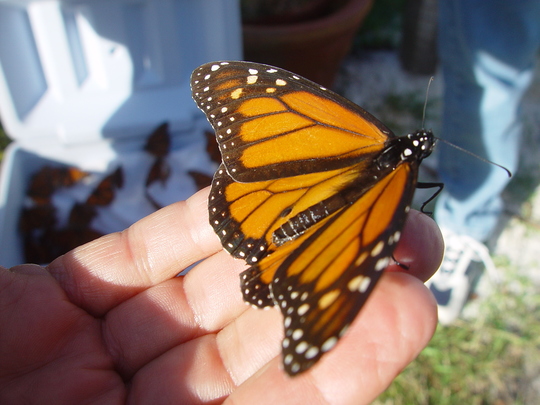FOR IMMEDIATE RELEASE: Jan. 2, 2015
APALACHICOLA NATIONAL
ESTUARINE RESEARCH RESERVE TAGS MIGRATING MONARCH BUTTERFLIES
~Staff members use tags for migration pattern research~
 Staff members and volunteers tagged more than 1,200 monarch butterflies.
APALACHICOLA –
The Apalachicola
National Estuarine Research Reserve completes its 14th year of tagging migrating
Monarch butterflies along the Apalachicola causeway bridge. This year, staff
and volunteers captured and tagged 1,213 of the long-distance fliers before
releasing them to continue their migration to Mexico.
The
Monarch butterflies are tagged during the early morning when temperatures are
low so that staff can safely collect them with very minimal stress to the
butterflies. There is a high concentration of Monarchs that roost on saltbushes
in a cold-slumber that allows for easy and safe collection of the insects by
hand. The captured Monarchs are kept in large plastic containers until they are
each given a feather-light coded tag that includes three letters and three
numbers that will associate the Apalachicola tag site with other points of
recovery for each butterfly.
“This
tagging project helps researchers determine the pathways taken during the
butterflies’ long migration from the U.S. to Mexico, which can be up to 3,000
miles long,” said Jennifer Harper, manager of the Apalachicola National
Estuarine Research Reserve. “For example, this year, the Apalachicola Research
Reserve team recaptured a Monarch that had been tagged in the St. Marks Refuge in
October.”
The
migration information is particularly important because it helps researchers
determine the influence of weather on the migration and the overall survival status
of Monarchs. Research indicates the Monarch population has declined up to 90
percent due to various factors such as habitat loss, land
management practices and some types of chemically aided agriculture. The loss of quality breeding habitat due to
increased use of herbicide-tolerant crops has been particularly harmful because
the butterfly’s host plant (milkweeds) has been essentially eliminated in the
agricultural landscape where they were once abundant. Because Monarchs are
viewed as a biological flagship species for conservation, monitoring the
population also helps to assess habitat loss at local, regional and
international levels.
In addition to
Monarch tagging, the Apalachicola Research Reserve education staff also
conducted five separate Monarch tagging demonstrations with 121 students and
staff from Franklin County Schools, grades pre-K through 7. Teaching
students about the life cycle (metamorphosis) of butterflies is an
excellent strategy to develop their awareness for similar biological processes
that occur throughout the natural world.
There
are many things people can do to help increase the Monarch population. One of
the easiest and most helpful options is to create breeding habitat for Monarchs
by planting milkweed that
is native to Florida. Native milkweed is the only food source that Monarch
butterflies will feed on and there are numerous species of native milkweed to
choose from. Host plants that are the easiest to grow in Florida are butterfly
weed (Asclepias tuberosa) and swamp
milkweed (Asclepias incarnata). Both are great nectar
sources for pollinators, provide breeding habitat and are readily available at
plant nurseries.
|